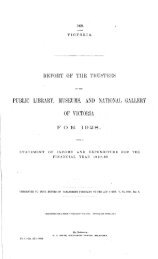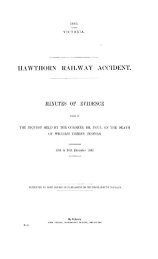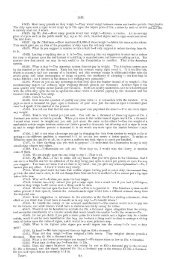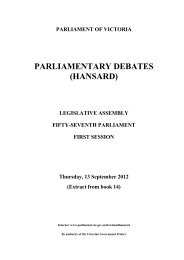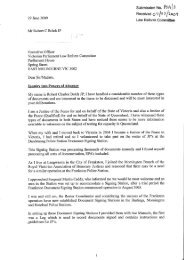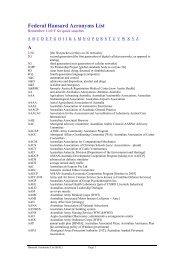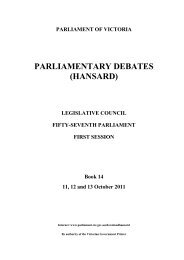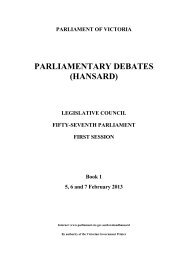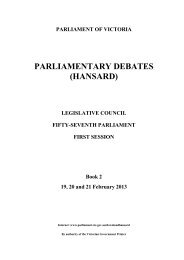Book 8 - Parliament of Victoria
Book 8 - Parliament of Victoria
Book 8 - Parliament of Victoria
You also want an ePaper? Increase the reach of your titles
YUMPU automatically turns print PDFs into web optimized ePapers that Google loves.
AUSTRALIAN SYNCHROTRON: FUNDING<br />
1638 COUNCIL Wednesday, 1 June 2011<br />
AUSTRALIAN SYNCHROTRON: FUNDING<br />
Mr SOMYUREK (South Eastern Metropolitan) —<br />
I move:<br />
That this house condemns the Baillieu government for putting<br />
further pressure on <strong>Victoria</strong>’s advanced manufacturing sector<br />
by failing to commit ongoing funding for the Australian<br />
Synchrotron and notes that the synchrotron —<br />
(1) is a major tool for research and development; and<br />
(2) plays an important part in the development <strong>of</strong> advanced<br />
new products and processes which are key elements in<br />
maintaining and growing <strong>Victoria</strong>’s manufacturing base.<br />
I am going to do something rather unusual today. I am<br />
going to commence my contribution by quoting from<br />
an interview between Peter Mares, who is the host <strong>of</strong><br />
the Radio National program National Interest, and his<br />
guest on the program Emeritus Pr<strong>of</strong>essor <strong>of</strong> Chemistry,<br />
Pr<strong>of</strong>essor Frank Larkins. I do this in order to give an<br />
insight into what the highly gifted individuals who<br />
actually use the synchrotron and the scientific<br />
community think about the potential closure <strong>of</strong> this<br />
facility and also to give an insight into how incredulous<br />
the scientific community is at the potential closure <strong>of</strong><br />
the Australian Synchrotron.<br />
As I would expect from a pr<strong>of</strong>essor, Pr<strong>of</strong>essor Larkins’s<br />
views are objective — that is, they are evidence based,<br />
unlike the polemic that goes on in this place. With the<br />
house’s indulgence — this is quite a lengthy<br />
interview — I will now commence.<br />
Peter Mares — How important is the synchrotron to<br />
Australian science and research?<br />
Frank Larkins — Oh, it’s absolutely critical. It’s a world-class<br />
facility which does represent what we would call<br />
displacement science. You can do experiments at the<br />
synchrotron that you cannot do in your laboratory and if you<br />
want to attract and retain world-class people, we want to be<br />
seen in the top echelons <strong>of</strong> research performance world wide<br />
… It’s a facility that we must have and it’s something that<br />
we’ve lobbied for since the early 1990s, in fact.<br />
Peter Mares — And are you worried about the future <strong>of</strong> its<br />
funding?<br />
Frank Larkins — Well, the future … It’s clearly <strong>of</strong> great<br />
concern to everyone that if we are, as I said earlier, to<br />
continue to be seen as a world-class contributor to science and<br />
technology, then it’s a must-have facility and the failure to put<br />
in place a forward plan for funding beyond 2012 is <strong>of</strong> great<br />
concern.<br />
Peter Mares — And so, could the synchrotron be shut down<br />
in the middle <strong>of</strong> next year? Is that conceivable?<br />
Frank Larkins — Well, we all hope not. I mean, it is in the<br />
hands <strong>of</strong> the politicians now. But that would be a disaster for<br />
Australia. It’s a disaster for science. And we just cannot allow<br />
that to happen. But yes, Peter, in theory, it could happen.<br />
Peter Mares — How did it come to this, where we build a<br />
world-class research facility at a cost <strong>of</strong> $200 million plus,<br />
and now we don’t know whether we’re going to fund it<br />
beyond the next 12 months?<br />
Frank Larkins — Well, you really need to ask other people to<br />
answer this question …<br />
Peter Mares — But as you say, this is now in the hands <strong>of</strong><br />
politicians. And part <strong>of</strong> the issue here, as I understand it, is<br />
that the Brumby government were big supporters <strong>of</strong> the<br />
synchrotron. In fact, it was known as ‘Brumby’s Baby’. The<br />
<strong>Victoria</strong>n government jumped in to get the facility before<br />
Queensland and New South Wales, that were both interested<br />
in it as well …<br />
Frank Larkins — I understand all that. I think we should just<br />
reflect for a moment, though, because in the early 2000s, the<br />
federal government was convinced <strong>of</strong> the importance <strong>of</strong><br />
Australia having such a facility and as you said, they set up a<br />
competition, and again, it’s an indication that the Queensland<br />
government, the New South Wales government, the <strong>Victoria</strong>n<br />
government, all saw this as a critical piece <strong>of</strong> national<br />
infrastructure, and all governments, the federal and the three<br />
eastern state governments, all said initially, ‘We want this<br />
facility’. So, the question is, what fundamentally has changed<br />
such that it is now not critical to our future? And the answer,<br />
<strong>of</strong> course, is that nothing’s changed; it is still critical to our<br />
future.<br />
I ask the same question: what has changed? Why has<br />
this vital facility that the federal government and the<br />
three eastern states competed for been seemingly wiped<br />
out by the Baillieu government with the stroke <strong>of</strong> the<br />
pen? If I may channel Pr<strong>of</strong>essor Larkins’s question:<br />
how has it come to this? I will answer that question a<br />
little later in my contribution, but first I want to talk<br />
about the synchrotron and what it does.<br />
The Australian Synchrotron is one <strong>of</strong> the most<br />
significant pieces <strong>of</strong> science infrastructure in the<br />
Southern Hemisphere. It was <strong>of</strong>ficially opened on<br />
31 July 2007 by the Brumby government. The facility<br />
was constructed with funding <strong>of</strong> $157 million from the<br />
<strong>Victoria</strong>n government’s capital fund and, as I recall,<br />
about $50 million <strong>of</strong> federal funding. The synchrotron<br />
is used for critical research and knowledge production<br />
across a wide range <strong>of</strong> applications, including<br />
manufacturing, health, minerals, materials, food<br />
security, climate change mitigation, energy security,<br />
homeland security and biosecurity.<br />
The advent <strong>of</strong> the synchrotron has significantly<br />
increased the depth and breadth <strong>of</strong> world-class research<br />
that can be undertaken by Australian and New Zealand<br />
scientists. Let us not forget New Zealand in this. The<br />
synchrotron is not just for <strong>Victoria</strong>ns and it is not just<br />
for Australia — New Zealand is also a stakeholder in<br />
this facility.<br />
The users <strong>of</strong> the synchrotron are rapidly diversifying to<br />
encompass a broad cross-section <strong>of</strong> the research




